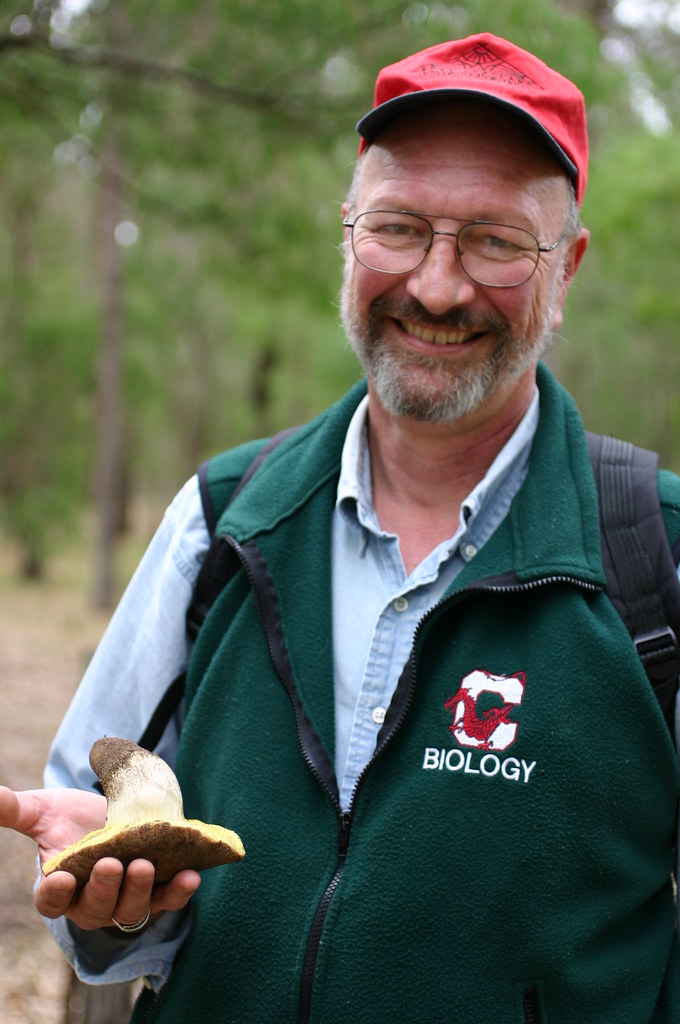Many a Fungus Among Us
Posted in Learning Experiences, People, Science on October 16 2008, by Plant Talk
 Carol Capobianco is Editorial Content Manager at The New York Botanical Garden.
Carol Capobianco is Editorial Content Manager at The New York Botanical Garden.
 With the recent wet weather you may have noticed that mushrooms are, well, mushrooming—in moist areas of your garden, on a pile of mulch, in a nearby woodland.
With the recent wet weather you may have noticed that mushrooms are, well, mushrooming—in moist areas of your garden, on a pile of mulch, in a nearby woodland.
Here at the Botanical Garden, from the end of June to the first frost you may see Dr. Roy Halling, Curator of Mycology, walking about the grounds after a significant rainfall in search of his favorite subject. He has dedicated his life’s work to studying mushrooms. “I want to know what they are, where they grow, and how they are related to each other.”
The casual observer can see about 40 to 50 different types of mushrooms at the Garden over the course of the season. Roy’s top three spots are Twin Lakes, the bottom of Azalea Way, and the Arthur and Janet Ross Conifer Arboretum. At the base of pines and oaks are the best places to look because of the symbiotic relationship between the roots of these trees and mushrooms.
Although, after almost 25 years on staff at the Garden, he knows where to look, he’s not always certain what he’ll find. “I search near Twin Lakes and used to find mushrooms there. The oak tree is still there, but there are different mushrooms now. The others either aren’t there or they’ve moved.”
Moved? Yes, mushrooms will travel—or actually not return and appear elsewhere—according to their nutrient needs.
Roy travels, too. He’s been to many parts of the world and has co-authored a guide to mushrooms of Costa Rica, but his specialty has been researching the fungi (the group to which mushrooms belong) of Australia and Southeast Asia. His current project, with a grant from the National Geographic Society, is to explore for and document the mushrooms on the world’s largest sand island, Fraser Island, north of Brisbane. Roy has found that fungi provide the nutrients for the survival of the rain forest that otherwise implausibly exists on this island.
Learn more about Roy and his work with mushrooms after the jump.
But far or near, Roy is committed to learning what isn’t known: It’s the reason he chose this field, recognizing that so much is yet to be discovered about mushrooms. In a recent video interview with NPR’s Science Friday about the ecological roles of mushrooms, Roy mentioned that only about 4 or 5 percent of the world’s 1.5 million fungi species are known.
That only enhances his curiosity. He’s not alone. As the new president of the Mycological Society of America, he leads a scientific association of over 1,000 members whose passion, and in many cases profession, also is fungi. But if you don’t know, say, your endophytes from your epiphytes, don’t fret. Roy says there are many organizations for the interested lay person. In fact, his recommendation for beginners is to join an amateur society and to buy a field guide, such as the one by the National Audubon Society written by Gary Lincoff, an instructor in the Botanical Garden’s Continuing Education program.
One recent day, a few minutes after chatting together about mushrooms, Roy reappeared in my office with three fungi he had picked up on a brief walk outdoors: one was a poisonous mushroom, the other a common mushroom, and yet another what appeared to be mold on a tulip tree leaf. He explained that this mold would help to eventually compost the leaf. “Organic matter is neither created nor destroyed; it is just recycled,” Roy is fond of saying. “Fungi are the primary organisms responsible for this recycling. They are nature’s recyclers.”
In the spirit of things, I decided to “recycle” this leaf and pinned it up alongside other found Garden treasures on my bulletin board. There it reminds me of the breadth and diversity of botanical species that exist, the interrelationships of organisms, and the remarkable work of the Garden’s scientists.

